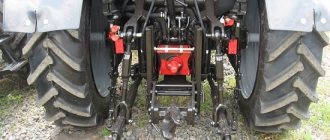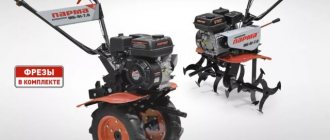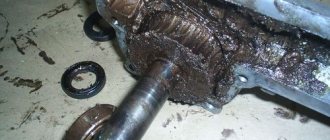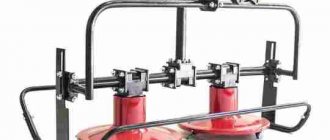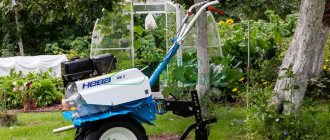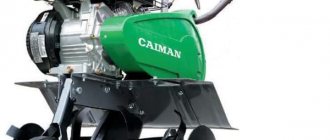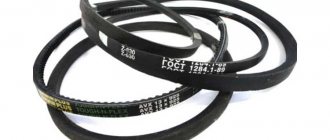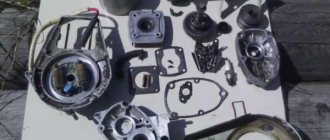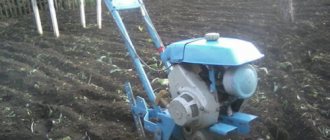Ways to increase speed on a walk-behind tractor
Many farmers are interested in how to increase the speed of a walk-behind tractor. The most common agricultural machinery is a walk-behind tractor. With its help, work on land and personal plots is greatly simplified. Let's look at how you can increase the speed of this technique. With increased speed, the performance and maneuverability of the mini-machine will increase, which can be used in any season and weather.
The best models of high-speed walk-behind tractors
A fast walk-behind tractor is an indispensable assistant when transporting goods in rural areas or when working over a large area. The diesel walk-behind tractor Centaur MB 1081D is the fastest among the heavy-duty walk-behind tractors and can reach speeds of up to 25 km/h. The Motor Sich MB-6D walk-behind tractor has a maximum speed of 16 km/h.
Popular models of walk-behind tractors from domestic manufacturers have a much lower maximum speed - on average, 12 km/h for MB-2 and MB-23, Neva. The Mobile-K Gepard walk-behind tractor also has a good speed - 12 km/h (4+1 gearbox).
How to increase the speed of a walk-behind tractor
You can increase the speed of the walk-behind tractor in two ways:
- installation of large wheels;
- replacing a gear pair.
Let's first look at how changing wheels helps increase the speed of a motor cultivator. The standard wheel size of almost all mini-unit models is 57 cm. When replacing, you can install tires 1.2 times larger in diameter. Typically, wheels of 70.4 cm are used. Despite the small difference, the speed of the walk-behind tractor increases noticeably. If the arches into which the tires are inserted allow you to insert wheels with a larger diameter, then you can try adding centimeters.
When using a walk-behind tractor for cultivating land, lugs are used. These are wheels with iron plates that freely grip the ground or snow. They can be purchased in specialized stores, or you can make them yourself. Their size also affects the speed of movement of the unit.
Let's look at how to increase the speed on a walk-behind tractor using the second method. Like any equipment, the cultivator has several speeds, which are controlled using gears. Typically, cultivators move at a speed of 2 to 15 km/h, with the large gear having 61 teeth and the small gear having 12. To increase the speed, the gear pairs of the gearbox are replaced. We increase the number of teeth, thus achieving the maximum speed of the walk-behind tractor.
It is recommended that replacement be carried out by professionals and preferably in specialized centers, since parts machined with minimal error will affect the operation of the motor. It is important not only to replace the gear, but also to select the correct pulley.
Maintenance
What does technical service entail? This is a series of measures that ensure proper operation and proper storage of equipment. Maintenance of the Krot cultivator means the following work:
- washing;
- cleaning;
- lubricant;
- control;
- gas station;
- control;
- fasteners;
- adjustment of all blocks and systems
Such work should be done as often as possible, especially if you have to work in unfavorable conditions.
Before starting the cultivator engine, you need to check the presence of fuel, oil, etc. You need to fill the mixture to a certain level, and if necessary, you need to change the fuel and oil. For cultivators, Avtol oil (M-8B) is used, which proved itself during the Soviet Union.
If it’s difficult to get it, you can use analogues:
- 10W-30 (do not use at temperatures above 27 degrees);
- SAE 30 (do not use at temperatures below 4 degrees).
Adjustment work involves adjusting the clutch, reverse gear, carburetor, spark, etc.
Cleaning work includes cleaning the filter, working surfaces, housing and all clogged parts on the surface of the Mole motor-cultivator. When defects appear, or for preventive purposes (less often), you need to clean the internal parts of the machine.
Before putting any part back in its original place, make sure it is in good working order.
Installation or replacement of any suspended equipment should take place with the engine completely turned off. When preparing for long-term storage, the motor cultivator requires conservation. To do this, you need to prepare the engine in a specific way (see instructions), then clean (wash) and dry all the external parts of the “Mole”, wipe them with a rag, drying them thoroughly. After which it is necessary to lubricate all accessible places of the cultivator with grease. Now the unit is ready for long-term rest.
Drive belt
The drive belt transmits torque from the motor to the gearbox. The reason for the breakdown of the “Mole” motor-cultivator is often a rupture of the drive belt. This occurs due to the belt jamming during operation due to heavy loads on the working parts of the cultivator (hard soil, blunt cutters). The cutter bends and catches the belt with the knife, thereby rendering it unusable.
Drive belts for the “Mole” cultivator can have different modifications, but their dimensions are strictly defined:
Reverse
The first modifications of the “Mole” were not equipped with a reverse function (reverse speed), which somewhat affected their operational properties and ease of working with such attachments as a cart, snow blower, mower, etc. To modify the “Mole”, the manufacturer released new its modifications, already with a reverse function, significantly increased the mobility of the cultivator.
Engine
The main reasons that the “Mole” engine does not start are:
- lack of fuel (or its low quality);
- problems with ignition discussed above;
- the occurrence of decompression and, as a result, piston wear and deformation of the exhaust valve.
READ Changing the Oil in the Neva Motoblock Engine
In the first case, it is quite easy to fill in the required amount of fuel (a mixture of gasoline and M-8V oil) and all problems will be resolved. In the case of a compression failure, you will have to completely disassemble the engine and replace damaged parts, and this could be a piston or an o-ring.
Deformation of the exhaust valve becomes another prerequisite for compression failure, which first leads to a loss of power of the “Mole” motor-cultivator, and then to starting dilemmas.
To restore the functionality of the motor, you need to completely disassemble it. Having assessed the condition of the piston, we replace it as necessary. We change the piston rings and exhaust valve. We examine the engine head, namely the gas distribution mechanism, and if there is carbon deposits, we clean it. If parts of the structure are damaged, we replace them with serviceable ones.
- There may be no ignition if the flywheel plates jam the magneto magnetic circuits.
- An incorrectly set gap between the electrodes will prevent the spark from jumping.
Once you have become familiar with the structure of the unit, you can safely move on to the repair and maintenance of motor cultivators.
How to make reverse gear on a walk-behind tractor
Let's look at how to make reverse gear on a walk-behind tractor. The presence of reverse depends on the model and dimensions of the mini-equipment. You can cultivate the land with a motor-cultivator, a light walk-behind tractor and a heavy unit. It all depends on your goals and objectives. Typically, when using models weighing up to 30 kg, there is no need for reverse speed, and it also complicates the design of the unit. On a heavy unit without this function it will be more difficult to perform work.
Without a gearbox, agricultural machinery will not move. It happens:
The purpose of the bevel gearbox is to ensure that the transmission collides with the engine, which affects the power of the gearbox. The gear is the transmitter between the motor and the wheels. A reduction gearbox is used to reduce the speed to increase power.
The reverse mechanism has a clutch located between the gears. They are located on the main roller. The main task of this system is to ensure the reverse movement of the vehicle. To make this mechanism yourself, the first step is to prepare the body, for which many people use a two-inch fitting square.
You can use a generator shaft from a Ural motorcycle. The gears will fit from the Druzhba chainsaw. You just need to drill a hole of the appropriate diameter in the shaft. On the opposite side, mount another gear shaft with bearings. And already on the weekend, install a pulley to ensure rotation.
You can purchase a ready-made gearbox, but when purchasing, it is better to give preference to more expensive mechanisms, since they are more reliable and last longer.
Among the malfunctions of gearboxes, users highlight the rapid wear of gears and the fact that the gear falls out.
If you increase the speed of the cultivator, you need to take into account that wear will occur much faster. When performing earthworks, you want to quickly complete the task. To increase or decrease the speed of movement, you can try the throttle. If the work ahead is hard, then when the gas is reduced the engine will stall.
The first speed is used when plowing the land, when more power of the unit is required. Accelerated work reduces the depth of cultivation.
Engine
When constructing a homemade motor cultivator, some make do with a drive from a scooter or moped. But to assemble a more productive walk-behind tractor, the power of the moped engine will not be enough. It will require a powerful 16-18 horsepower diesel engine from a motorcycle. It is “customized” to the required parameters, but sometimes it needs to be modernized. The gas tank is also installed from a scooter.
First, the cooling system is rebuilt into an active air one in order to improve the technical performance of the motorcycle. This is easy to do using a 12-volt electric motor with a small iron impeller. At the same time, the valve is replaced with a reed valve, which helps facilitate starting, increase traction and reduce fuel consumption.
The prepared engine is mounted in rigid clamps. They are first welded to the front of the homemade frame, then securely bolted together (the whole process is clearly shown in the video).
Be sure to ensure that the clamps cover the journal of the output shaft of the diesel motor of the walk-behind tractor and hold it firmly.
A lever is attached to the gearbox of a homemade device, which can be easily made from an iron rod by welding a ball at the end. The length of the handle is left such that, being behind the control handles of a walk-behind tractor or cultivator, you can easily reach it.
Next, for a homemade product, an air purification filter is assembled using available materials, for example, a tin can or a metal tube. Then prepare the fuel tank of the homemade motor unit. You can make it yourself from any sealed container or take it from a broken motorized stroller.
How to make a gearbox for a walk-behind tractor with your own hands
Making a gearbox for a walk-behind tractor with your own hands is a difficult and at the same time interesting task. This is one of the important mechanisms, without which the operation of garden equipment using a walk-behind tractor is unthinkable. Its main task is to reduce the speed of the drive shaft and at the same time increase or decrease the torque to the drive.
Modification of the rotors of the "Mole" motor cultivator
Motor cultivators "Mole"
, produced by the Moscow MPO named after. V.V. Chernyshova, have become widespread among gardeners, who usually buy them complete with rotors, which is enough for cultivating the soil on individual plots.
In Fig. 7a shows part of a motor cultivator with rotors on the left side. Using this part as an example, we will analyze some of the shortcomings of the “Mole”
, or rather, the shortcomings of its rotors. First of all, we note that the rotor knives are very blunt, and the pins that secure the inner rotor to the gearbox shaft and the outer rotor to the inner rotor protrude too much from the rotor shafts. As a result, roots and stems of plants are wound around the protruding parts of the pins, which, together with soil, clog the space between the internal rotor and the gearbox housing, as well as between both rotors. All this creates additional load on the gearbox shaft, and the rotors begin to rotate unevenly.
Types of gearboxes
The design of any converting device for a walk-behind tractor (gearbox) consists of a set of motion-transmitting shafts or gears of different diameters, enclosed in a durable housing.
Converting devices are divided into several types according to the type of transmission:
- chain;
- belt;
- gear;
- worm (gear-worm);
- combined systems.
For chain-type gearboxes, rotation transmission is provided using a chain and sprockets of different sizes, which are installed on rotary shafts. The operating principle of a belt mechanism is similar to a chain mechanism, but instead of sprockets and a chain, pulleys and a belt are used.
Inside the housing of the gear reducer there are shafts with gears mounted on them, having straight or oblique teeth. Gears transmit rotation from the engine to moving parts. Bevel gears are used in angular mechanisms for heavy walk-behind tractors.
Types of mechanisms
According to the method of operation and action, all transforming mechanisms for walk-behind tractors are divided into several types:
- angular;
- downward;
- reverse with reverse speed (reverse gearbox);
To redirect rotational energy from a vertical drive to a horizontal plane, an angular gearbox using bevel gears (bevel gearbox) is used.
Reducing the number of revolutions and increasing the power of the drive mechanism is provided by reduction gearboxes, or creepers for the walk-behind tractor. They are considered the most reliable for operating a diesel or gasoline air-cooled walk-behind tractor. This allows them to be used for particularly difficult work - for example, plowing heavy soil or harvesting potatoes using a potato digger.
How to make a homemade gearbox for a walk-behind tractor
To independently assemble the converting device on a walk-behind tractor, you need to stock up on the following tools:
- calipers and metal ruler;
- a set of screwdrivers of different sizes, including an oblique one;
- pliers and wire cutters;
- metal saw;
- electric drill with a set of metal drills;
- vice;
- hammers - large and small;
- rubber gaskets.
If you decide to assemble the gearbox for your walk-behind tractor yourself, be sure to make an approximate calculation. This will help determine, at a minimum, the gear ratio and type of converter you need.
Also, using preliminary calculations, you can estimate the dimensions of the future transmission device.
To make the correct calculation, determine the parameters of your engine. For calculations it is necessary to clarify several data:
- Engine crankshaft speed. However, this value is not constant: if you “add the gas”, it will increase significantly. Therefore, calculations are based on the base - the number of idle speeds plus 10%.
- Estimated number of revolutions for the suspension axle. It is calculated taking into account the diameter of the wheels to determine the run-out per full revolution. Based on this, you can calculate at what speed the axis should rotate in order to ensure the most comfortable speed of movement of the walk-behind tractor. This is on average from 3 to 5 km/h.
Let's take a simple example: the engine power at idle, taking into account an increase of 10%, is 600 rpm, and to ensure a speed of 3 km/h, a rotation speed of 200 rpm is required. Therefore, the design gear ratio is 3:1. In other words, to reduce the rotation speed of the axle by a factor of three to ensure a travel speed of 3 km per hour, the torque increases three times.
Step-by-step instructions for assembling a chain gearbox
If you have certain skills, you can make any type of gearbox with your own hands, but the easiest way is to assemble a small-sized mechanism with a chain drive. Materials for it are easier to find and are reliable in operation.
To make a homemade chain mechanism, stock up on the following spare parts and materials:
- sprockets with the required number of teeth;
- driven shaft;
- cylindrical and eccentric bearings;
- protective casing;
- fasteners for connecting parts of the casing;
- chains with the required number of links.
When assembling a gearbox of any design, you cannot replace bearings with bushings. Distortions between the driving and driven parts are unacceptable.
You can use an old gearbox housing of a suitable size as a protective casing, drilling holes in it for mounting.
- The manufacture of a homemade gearbox for a walk-behind tractor begins with securing the drive sprocket to the output shaft of the engine. To secure it, you can use a key or flange. Depending on the design of the output shaft, even spot welding can be used.
- The driven shaft should be machined. The sprocket is fixed on it in the same way as on the drive shaft.
- A more reliable way is to make a shaft from two axle shafts, at the ends of which flanges are machined. The driven sprocket is secured between them, fastening the entire structure with bolts. In this option, the second stage sprocket will be secured more accurately and reliably.
- To protect the gear mechanism from dirt and mechanical damage, it is placed in a protective housing, which also serves as a reservoir containing liquid lubricant for moving parts.
- Sockets are drilled in the protective housing (crankcase) for installing support bearings. The driven shaft is mounted on cylindrical bearings, and the drive shaft is mounted on eccentrics. By changing, due to its design features, the position in the seat within a radius of 15°, the eccentric bearing also changes the position of the drive shaft, thus adjusting the chain tension.
Making a homemade walk-behind tractor from a motorcycle engine
For normalized operation of the walk-behind tractor, it is necessary to develop a kinematic multi-stage transmission scheme. It allows you to increase the additional ratio, torque and tractive effort. Also, together with the gearbox adapter, the entire circuit provides for the presence of a main gearbox. The most highly efficient engine is obtained by combining the main gear with a geared wheelset.
Thanks to a specialized mechanism, the drive chains are effectively tensioned. This element is attached to the sliders using pins made of steel angles, which, in turn, are able to move freely, stretch, and also weaken the drive chain. A pair of adjusting screws with mounting bolts numbered M10 allows you to perform the above functions.
One of the most complex structures is the main gearbox, made of 10 mm steel plates. Reinforcing disks are located at the mounting bearing location. In order to eliminate the possibility of oil leakage, special continuous welding seams are made. The rear gear wall assumes in its structure the presence of a bracket - a bracket. It is capable of fastening both entire cargo trolleys and agricultural trailers. If you attach the cart to a walk-behind tractor, you will get a real miniature tractor.
(1) How to make reverse speed, NEVA 2.
The gear cover is made of a five-millimeter steel plate. Thanks to screws number M6, it is freely attached to the body. All straight gear gears are taken from agricultural machines.
Locking the wheels of a walk-behind tractor with a motorcycle engine
An important technical solution regarding the walk-behind tractor is the correct wheel locking. It is imperative to grind the cylindrical neck located on the right half axis next to the splined end. A threaded hole is made on the other axial side. During rotation of the screw number M12, a certain displacement is performed under the action of a cylindrical spring. After the specified moment, the axle shaft moves away from the gears. This is how the wheels are locked.
Motoblock wheels are made from electric car wheels. Sixteen grooves are cut in all disks. Steel plates are welded there. Then jumpers are added, which form the rim of the arable elements.
READ Circular DIY Engine
Sergey Kuchin | Topic author: Motoblocks
Hello! Is it worth buying a Forza walk-behind tractor?
Grigoriev (Levar) I don’t know! I tried the Forza engine and didn’t like it! I consumed a lot of gasoline and the vibration was strong.
Nikolay (Ferris) he probably means the Forza walk-behind tractor
Grigoriev (Levar) Perhaps. But I told you about the engine. I’ve never seen a walk-behind tractor like this.
Evgeny (Coffey) There is no ideal walk-behind tractor, take the one that you like. It’s a walk-behind tractor and not a cultivator, so that there are at least two speeds, and a reverse speed, and the rest is that. Almost all of their engines are Chinese and they are made almost in the same place. I have a Chinese Salute, my neighbor has a Champion, another Mitsubishi is also Chinese and they work nothing, they plow.
Vyacheslav (Yashawn) Normal device, everything is the same for everyone, ray Neva, virgin soil
Valentin (Demetres) I would advise you to pay attention to walk-behind tractors where the clutch and drive are beltless. They are more reliable, although perhaps a little more expensive.
Grigoriev (Levar) For example, Ugra! But I haven’t heard many reviews about it, and the sellers themselves say that it’s not very good. The box is very weak.
Valentin (Demetres) Alas, I won’t say anything for Ugra. I have a Centaur 2070. No complaints. What do the sellers say? Well, for example, if you compare a chain drive and a gear drive, then the choice is definitely in the direction of the latter. Or have you heard about cars with chain transmission?
Vitaly (Haoniyao) A successful comparison of cars and MB!
Sergey (Sedat) Hello guys, this year I took the Neva from a Subaru, so when buying, the seller explained how the Chinese differ from ours, the gears in the gearbox are rural and steel, respectively
Sergey (Sedat) Celumin and steel
max (Resa) I really liked the Ugra. 8 years old, he only changed the old engine and it started to eat up the oil. The engine was stuck in the Lifad engine since there was no Lifanov engine in the store. The champion installed it in the box. walks from the visna until the first snow.
Valentin (Demetres) I already mentioned that almost everyone in our area is Chinese. With a box. and in particular with gears, none of my friends had problems. There have been cases where the chains in the cutter drive of heavy milling machines broke. and as for the “explanations” of the sellers, then, as they say, every frog praises its own swamp. This is a biased expert, IMHO!
Alexey (Bautista) It’s not worth it, if you have money, take it, if there’s something better, take it, the choice always comes down to money, so we’ll take it for what we have.
Evgeniy (Coffey) Of course, the Prado Kruzak has a chain transfer case, and on many jeeps I changed the chain like that and that’s it, instead of an expensive transmission
Valentin (Demetres) Ford, EMNIP, used a chain drive in its first models.
Tags: How to make reverse speed on a walk-behind tractor video
User manual
In the operating instructions supplied with the Mole walk-behind tractor, the manufacturer indicates the following information:
- setting up mechanisms and troubleshooting;
- safety rules when working with the unit;
- features of using the device;
- information about the parameters and structure of the agricultural machine.
Reliable and long-term operation of the walk-behind tractor depends on proper and regular maintenance, as well as on competent and constant care. The user needs to perform simple manipulations to care for the mechanism. In this case, the cultivator can last more than 10 years.
As fuel, you must use a mixture of AI-80 or AI-76 gasoline and M-12-TPTU or M8V1 oil.
The operation of the walk-behind tractor depends on proper and regular maintenance.
The oil level must be constantly monitored and, if necessary, replenished to the required amount. After each use of the cultivator, it is important to clean it from dirt. At the end of the procedures, the agricultural machine is wiped dry and its working units are lubricated.
MK-5-01
The technical characteristics of this modification are the same as the previous model. The main difference is the presence of a 4 hp Honda GC135 engine.
The walk-behind tractor has a chain gearbox and a belt clutch, as well as rear and forward speeds. The weight of the device is 53 kg, its steering column has only one position. The cultivation width ranges from 34 to 90 cm. The dimensions of the mechanism coincide with the MK-4-03 model.
No spark
The reason for the lack of spark is a faulty spark plug, namely:
- carbon deposits - clean the candle;
- a spark appears, but the engine does not start - oil or fuel has got onto the tip of the spark plug;
- fuel fills the cylinder from time to time, which leads to the spark plug becoming wet and causing no spark;
- spark plug failure;
- A faulty O-ring is a possible cause of the malfunction.
Electric ignition malfunctions may also be the reason why tractor does not start
Belt replacement
You should purchase a belt for the Mole walk-behind tractor in accordance with the manufacturer’s instructions in the instructions. Installing unsuitable models from unknown manufacturers will result in additional problems.
To replace the belt, proceed as follows:
- Switch to neutral gear and turn off the engine.
- Remove the protective cover and old belts.
- Even if one of the belts is not worn enough, both should be replaced. You can use scissors for removal.
- Remove the pulley from the drive shaft and put new belts on the gearbox shaft pulley.
- Take the removed pulley and pull the belts onto it, then install it on the motor shaft. In this case, the key must be installed correctly, otherwise the pulley will not rotate.
- Make sure that the belts are not distorted and place them on top of the tension rollers.
- Attach the protective cover in place.
Does not start
If tractor , you need to check the following parameters:
- fuel flow into the carburetor;
- control lever position;
- inspect the spark plug;
- make sure there is fuel in the tank.
It is necessary to check the flow of fuel into the carburetor if the walk-behind tractor
It is important to determine why the Mole walk-behind tractor does not start; the reasons for this may lie in electrical ignition faults.
To make sure of this, you should:
- Unscrew the spark plug. If it is dry, this is a sign that gasoline is not getting to the carburetor. It is necessary to dry the cylinder and bleed the engine when the spark plug is wet. If there is carbon deposits, it is necessary to clean it with sandpaper soaked in gasoline.
- Check the ignition by turning the crankshaft. Normally, a bright blue candle should be visible.
- Replace the spark plug with a new one if the problems persist.
- Check that the gap between the coil and the ignition wire is correctly set.
- Make sure the fuel hose is in good condition.
- Check to see if the magneto and flywheel wires are tight.
Unidentified violations during self-check are a reason to contact a service center for professional repair of the unit.

